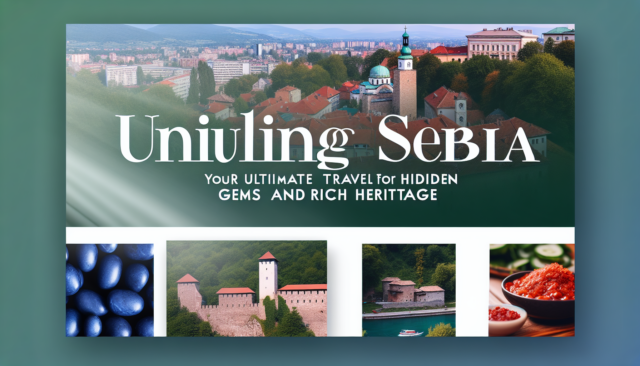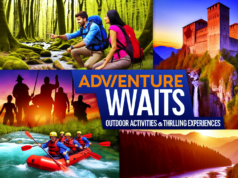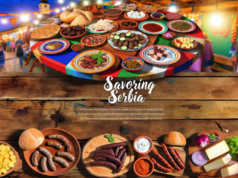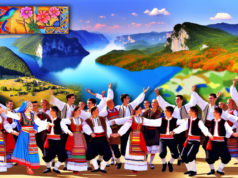
Unveiling Serbia: Your Ultimate Travel Guide to Hidden Gems and Rich Heritage
Nestled in the heart of the Balkan Peninsula, Serbia is a country that often flies under the radar for travelers seeking hidden gems and authentic experiences. With its stunning landscapes, rich history, vibrant culture, and warm hospitality, Serbia beckons adventurers ready to explore its lesser-known treasures. This ultimate travel guide will take you off the beaten path, unveiling the hidden gems and rich heritage of this captivating country.
A Tapestry of Culture and History
Serbia’s history dates back thousands of years, with influences from various civilizations, including the Romans, Ottomans, and Austro-Hungarians. The country is dotted with historical sites that offer a glimpse into its complex past.
1. Belgrade: The Dynamic Capital
Start your journey in Belgrade, Serbia’s bustling capital, where the confluence of the Sava and Danube rivers sets the stage for a city that never sleeps. Explore the impressive Belgrade Fortress, which overlooks the rivers and provides panoramic views of the city. Don’t miss out on the bohemian quarter of Skadarlija, renowned for its charming cobblestone streets, traditional restaurants, and vibrant nightlife.
2. Novi Sad: Home of the Petrovaradin Fortress
Just an hour from Belgrade, Novi Sad stands as a testament to Serbia’s artistic spirit, especially during the famous EXIT Festival held annually at the Petrovaradin Fortress. This 18th-century fortress is a spectacular sight, with its labyrinthine passageways and stunning views of the Danube. The city itself is also home to a charming old town, complete with baroque architecture and delightful café culture.
3. Niš: The Historical Crossroads
Take a trip to Niš, one of the oldest cities in Europe, known as the birthplace of Roman Emperor Constantine the Great. Visit the formidable Niš Fortress, wander the historic Čegar Hill, and reflect at the haunting Skull Tower, a monument built using the skulls of insurgents by the Ottomans.
Nature’s Bounty
Beyond its urban centers, Serbia boasts breathtaking landscapes that are perfect for outdoor enthusiasts.
4. Tara National Park: A Nature Lover’s Paradise
Located in western Serbia, Tara National Park offers stunning natural beauty with lush forests, river canyons, and alpine meadows. Hiking, biking, and kayaking are popular activities here, while the serene Drina River provides a perfect backdrop for relaxation. Don’t forget to visit the iconic Drina River House, a house precariously perched on a rock in the middle of the river.
5. Djerdap Gorge: The Iron Gates
Venture to the eastern part of Serbia to find the Djerdap National Park, home to the Iron Gates, a breathtaking gorge formed by the Danube River. The area teems with wildlife and offers a variety of hiking paths, but the real highlight is the picturesque views of the river, cliffs, and the ancient ruins of the Roman settlement of Diana.
6. Fruška Gora National Park: Wine and Nature
If you are a wine enthusiast, make your way to Fruška Gora National Park, famous for its grape plantations and monasteries. This serene park, characterized by rolling hills and tranquil lakes, is a great place to explore hiking trails, sample local wines, and discover Serbian Orthodox monasteries that date back to the 15th century.
Cultural Experiences
7. Traditional Villages: A Step Back in Time
To truly experience Serbia’s rich heritage, venture into its rural heart. Villages like Drvengrad (also known as Küstendorf), built by filmmaker Emir Kusturica, offer a glimpse into traditional Serbian life. Here, wooden houses blend seamlessly with an artsy ambiance, complemented by lively cultural festivals.
8. Culinary Delights
No trip to Serbia is complete without indulging in its culinary delights. Try the famous ćevapi (grilled minced meat), sarma (cabbage rolls), and rakija (fruit brandy). Visit local markets for fresh produce, artisanal cheeses, and traditional pastries. And if you have a sweet tooth, don’t miss out on torta or domaće (homemade pastries) – a perfect ending to your meal.
Practical Tips for Travelers
- Language: While Serbian is the official language, English is commonly spoken in tourist areas, especially by younger generations.
- Transportation: Serbia has a well-established public transport system, including buses and trains that connect major cities. Renting a car is also a good option for exploring rural areas.
- Best Time to Visit: Spring (April to June) and Fall (September to October) are ideal for pleasant weather and fewer crowds. However, winter offers picturesque snowy landscapes, ideal for winter sports enthusiasts.
- Currency: The local currency is the Serbian dinar (RSD). Credit cards are widely accepted, but it’s wise to have some cash for local markets and smaller establishments.
Conclusion
Serbia is a country that offers a myriad of experiences beyond its well-trodden paths. From its rich historical tapestry and vibrant cities to breathtaking natural landscapes and warm local hospitality, Serbia invites you to uncover its hidden gems. Immerse yourself in its culture, indulge in delightful culinary offerings, and create memories that will last a lifetime. So pack your bags and get ready to unveil the wonders of Serbia!













